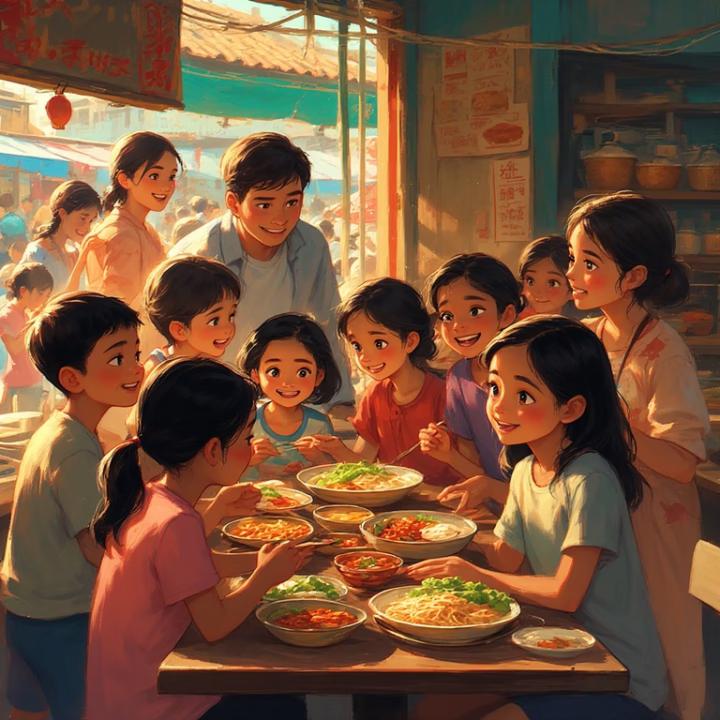
In the heart of George Town, where the air hummed with the sizzle of woks and the scent of turmeric, chili, and coconut milk swirled through the breeze, stood the Penang Sentral Food Court. It wasn’t fancy—just a bustling open-air plaza under a red-and-yellow striped awning, with rickety tables, plastic stools, and steam rising from dozens of tiny stalls. But to the children who gathered there after school, it was a kingdom of flavor, a crossroads of cultures, and the most magical place in the world.
Every afternoon, the food court came alive with laughter, clattering plates, and the rhythm of languages dancing together—Malay, Mandarin, Tamil, English, and sometimes a mix of all four in one sentence. And this is where our story begins, on a sweltering Tuesday, with five kids who didn’t know they were about to become friends.
Eddy, twelve and quick on his feet, balanced a tray of char kway teow—his father’s famous stir-fried flat noodles—while dodging a group of scooter-riding uncles. He ran the stall with his dad after school, flipping noodles like a pro. His apron was always stained, but his smile was brighter than the neon Hawker Special sign above them.
At a nearby table, Anna, ten and curious as a cat, dipped a spoon into a bowl of bubur cha cha—a sweet coconut milk dessert with yam and tapioca pearls. She had just moved from Kuala Lumpur with her grandmother, and everything in Penang still felt new: the way people waved at strangers, the music from the Indian spice shop, the rainbow of dishes she’d never tasted before.
Beside her sat Lily, quiet and observant, sketching the food court in her notebook. Her pencil moved fast, capturing the curve of a roti canai flipping in the air, the steam from a laksa bowl. She rarely spoke, but her drawings told stories no one had asked for—yet.
Near the juice stall, Bell and Vivian argued over a single cendol.
“I saw it first!” Vivian said, arms crossed.
“You blinked,” Bell shot back, grinning.
They were sisters—twins, actually—but acted more like rivals. Bell loved spicy food; Vivian couldn’t handle chili. Bell wore her hair in two puffballs; Vivian kept hers in a sleek braid. But they both adored their mother’s asam laksa, and they always ended up sharing.
And then there was Emma, new to the group, standing alone near the entrance, clutching a small container of kimchi bokkeumbap—Korean fried rice her mom had packed. She looked around, unsure. She had just moved from Seoul, and though she spoke English, the sounds and smells of this place overwhelmed her. She missed the quiet of her old school, the familiar taste of home.
That’s when Eddy spotted her.
“Hey!” he called, waving a wooden spatula. “You gonna eat that, or just stare at it?”
Emma blinked. “I… I don’t know where to sit.”
Eddy grinned. “Then sit with us. More food, more friends. That’s the food court rule.”
Before she could answer, Anna scooted over. “I saved a seat! And I have extra pau if you want one.”
Lily looked up from her sketch and nodded shyly.
Bell and Vivian exchanged a glance. “Only if she shares that kimchi,” Vivian said.
“Only if it’s not too spicy,” Bell added.
Emma hesitated—then smiled. She opened her container. “It’s spicy. But good.”
Eddy leaned in. “Spicy is life.”
And just like that, the Friendship Table was born.
Every day after that, they met at the same corner table. No one claimed it—it just became theirs. They traded bites of food like trading cards:
Eddy brought chee cheong fun—rice noodle rolls with sweet soy and sesame seeds.
Anna shared putu piring, steamed coconut cakes that melted on the tongue.
Lily, surprisingly, brought her mother’s ayam pongteh, a Peranakan chicken stew rich with fermented soybean and garlic.
Bell smuggled spicy salted egg yolk fish skin from her dad’s snack shop.
Vivian brought rose syrup drinks that turned their lips pink.
And Emma, slowly growing bolder, brought mandu (dumplings), tteokbokki (spicy rice cakes), and once, a mysterious purple drink called sujeonggwa that tasted like cinnamon and honey.
They didn’t just eat. They learned.
Anna taught them how to say “thank you” in Korean.
Lily showed them how to fold a paper lotus like her grandmother taught her.
Emma explained that in Korea, sharing food meant trust.
Eddy told them that in his family, cooking together meant love—even if you burned the rice.
Bell and Vivian argued about whose turn it was to pour the tea, then laughed when they spilled it on the tablecloth.
One rainy afternoon, as thunder rumbled over the rooftops, they huddled under the awning, eating otak-otak (spiced fish mousse in banana leaves) and telling stories.
“My grandma says food is memory,” Anna said, chewing slowly. “When I eat bubur, I remember her kitchen, the way she hums while she stirs.”
“My mom says food is peace,” Lily said softly. “When people share a meal, even if they don’t speak the same language, they understand each other.”
Emma nodded. “In Korea, we say sikida jogeum, hana hamkke—‘Let’s eat a little, together.’”
Eddy raised his spoon. “Then let’s make a rule: No one eats alone.”
They clinked spoons—plastic, mismatched, sticky with sauce—and made it official.
Weeks passed. The Friendship Table grew. Other kids started joining—Hyuga, whose Japanese mom ran a sushi cart, brought onigiri shaped like pandas. Pye, a quiet boy from Myanmar, shared shwe yin aye, a cool jelly dessert with coconut milk. Even Alexis, the French-Malay girl who always wore headphones, took them off long enough to taste Eddy’s rojak and say, “C’est incroyable!”
The food court buzzed with their laughter. The aunties from the stalls began saving special plates for them. “For the rainbow children,” one called them. “The ones who eat the world.”
One evening, the local newspaper came by to write a story about the food court. The reporter asked the kids, “What makes this place special?”
Lily, still quiet, held up her sketchbook. It showed all of them around the table, hands reaching across dishes of different colors and shapes, a single thread connecting each plate like a circle of light.
Anna said, “We’re all different. But when we eat together, we’re the same.”
Emma smiled. “We all have hunger. And we all have joy.”
Eddy grinned. “And we all hate it when someone steals the last pau.”
They laughed.
The article was published with the headline:
“The Table That Tastes Like Home: How a Food Court in Penang Became a Feast of Friendship.”
Years later, when the kids had grown, moved away, or started their own food stalls, they still returned to that same table when they could. And every time, they brought a dish from wherever they’d been—Korean, Indian, Malay, Chinese, French, Burmese, Japanese—laying them out like a map of their lives.
Because they had learned something simple, something deep:
Food doesn’t just fill the stomach.
It builds bridges.
It turns strangers into family.
And sometimes, in a noisy, steamy food court in Penang, it starts a feast that never ends.
The End.










